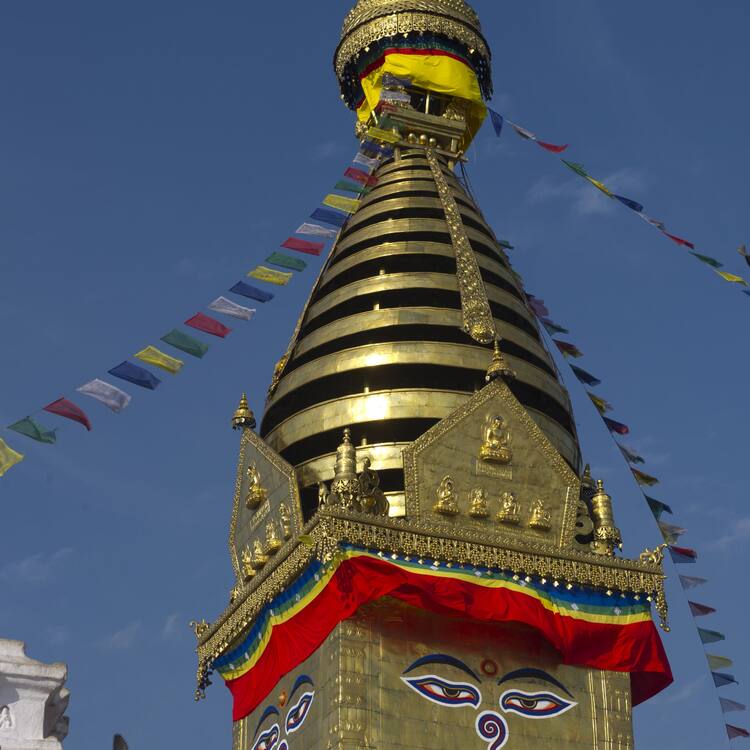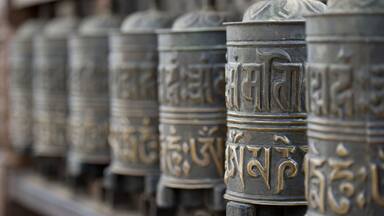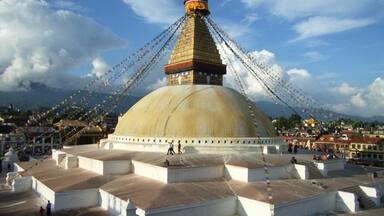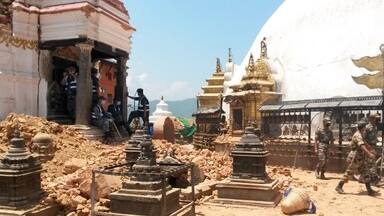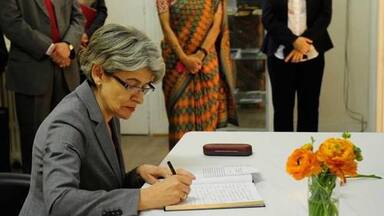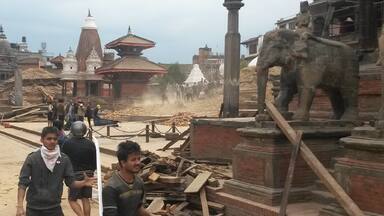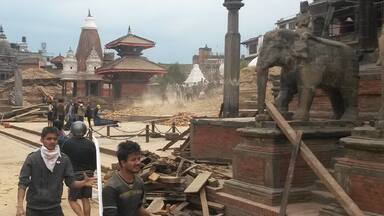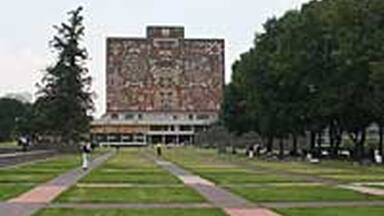Kathmandu Valley
Kathmandu Valley
The cultural heritage of the Kathmandu Valley is illustrated by seven groups of monuments and buildings which display the full range of historic and artistic achievements for which the Kathmandu Valley is world famous. The seven include the Durbar Squares of Hanuman Dhoka (Kathmandu), Patan and Bhaktapur, the Buddhist stupas of Swayambhu and Bauddhanath and the Hindu temples of Pashupati and Changu Narayan.
Description is available under license CC-BY-SA IGO 3.0
Vallée de Kathmandu
Le patrimoine culturel de la Vallée de Kathmandu est illustré par sept ensembles de monuments et constructions, couvrant l’éventail complet des réalisations historiques et artistiques qui ont rendu la Vallée de Kathmandu mondialement célèbre. Ces sept ensembles comprennent les places Durbar de Hanuman Dhoka (Kathmandu), Patan et Bhaktapur, les stupas bouddhistes de Swayambhu et Bauddhanath ainsi que les temples hindous de Pashupati et de Changu Narayan.
Description is available under license CC-BY-SA IGO 3.0
وادي كاتماندو
يظهر التراث الثقافي في وادي كاتماندو من خلال مجمّعات الآثار والعمارات السبعة التي تغطي تشكيلة المنشآت التاريخية والفنية الكاملة التي جعلت وادي كاتماندو مشهورًا في أنحاء العالم كلّه. وتتضمَّن هذه المجمّعات السبعة ساحات دوربار في هانومان دوكا (كاتماندو) وباتن وباكتابور والمعابد البوذية في سوايامبو، بالاضافة الى المعابد الهندوسية في باشوباتي وشنغو نارايان.
source: UNESCO/CPE
Description is available under license CC-BY-SA IGO 3.0
加德满都谷地
加德满都谷地文化遗产有七组历史遗址和建筑群,全面反映了加德满都谷地闻名于世的历史和艺术成就。七组历史遗址包括加德满都、帕坦和巴德冈王宫广场、斯瓦亚姆布与博德纳特佛教圣庙和伯舒伯蒂与钱古·纳拉扬印度神庙。
source: UNESCO/CPE
Description is available under license CC-BY-SA IGO 3.0
Долина Катманду
Культурное наследие долины Катманду иллюстрируется 7 группами памятников и зданий, представляющих собой самые значимые достижения в архитектуре и искусстве, благодаря которым эти места прославились на весь мир. Эти группы памятников включают: три площади Дурбар - в Катманду (комплекс Хануман Дхока), Патане и Бхактапуре, буддийские ступы Сваямбхунатх и Бодхнатх, а также индуистские храмы Пашупати и Чангу-Нараян.
source: UNESCO/CPE
Description is available under license CC-BY-SA IGO 3.0
Valle de Katmandú
El sitio del valle de Katmandú comprende siete conjuntos de monumentos y edificios representativos de la totalidad de las obras históricas y artísticas que han hecho mundialmente célebre al valle de Katmandú. En esos siete conjuntos están comprendidas: las tres plazas Durbar situadas frente a los palacios reales de Hanuman Dhoka (Katmandú), Patán y Bhaktapur; las estupas budistas de Swayambhu y Bauddhabath; y los templos hinduistas de Pashupati y Changu Narayan.
source: UNESCO/CPE
Description is available under license CC-BY-SA IGO 3.0
カトマンズの谷
source: NFUAJ
Kathmandu vallei
Source: unesco.nl
Outstanding Universal Value
Located in the foothills of the Himalayas, the Kathmandu Valley World Heritage property is inscribed as seven Monument Zones. These monument zones are the Durbar squares or urban centres with their palaces, temples and public spaces of the three cities of Kathmandu (Hanuman Dhoka), Patan and Bhaktapur, and the religious ensembles of Swayambhu, Bauddhanath, Pashupati and Changu Narayan. The religious ensemble of Swayambhu includes the oldest Buddhist monument (a stupa) in the Valley; that of Bauddhanath includes the largest stupa in Nepal; Pashupati has an extensive Hindu temple precinct, and Changu Narayan comprises traditional Newari settlement, and a Hindu temple complex with one of the earliest inscriptions in the Valley from the fifth century AD. The unique tiered temples are mostly made of fired brick with mud mortar and timber structures. The roofs are covered with small overlapping terracotta tiles, with gilded brass ornamentation. The windows, doorways and roof struts have rich decorative carvings. The stupas have simple but powerful forms with massive, whitewashed hemispheres supporting gilded cubes with the all-seeing eternal Buddha eyes.
As Buddhism and Hinduism developed and changed over the centuries throughout Asia, both religions prospered in Nepal and produced a powerful artistic and architectural fusion beginning at least from the 5th century AD, but truly coming into its own in the three hundred year period between 1500 and 1800 AD. These monuments were defined by the outstanding cultural traditions of the Newars, manifested in their unique urban settlements, buildings and structures with intricate ornamentation displaying outstanding craftsmanship in brick, stone, timber and bronze that are some of the most highly developed in the world.
Criterion (iii): The seven monument ensembles represent an exceptional testimony to the traditional civilization of the Kathmandu Valley. The cultural traditions of the multi ethnic people who settled in this remote Himalayan valley over the past two millennia, referred to as the Newars, is manifested in the unique urban society which boasts of one of the most highly developed craftsmanship of brick, stone, timber and bronze in the world. The coexistence and amalgamation of Hinduism and Buddhism with animist rituals and Tantrism is considered unique.
Criterion (iv): The property is comprised of exceptional architectural typologies, ensembles and urban fabric illustrating the highly developed culture of the Valley, which reached an apogee between 1500 and 1800 AD. The exquisite examples of palace complexes, ensembles of temples and stupas are unique to the Kathmandu Valley.
Criterion (vi): The property is tangibly associated with the unique coexistence and amalgamation of Hinduism and Buddhism with animist rituals and Tantrism. The symbolic and artistic values are manifested in the ornamentation of the buildings, the urban structure and often the surrounding natural environment, which are closely associated with legends, rituals and festivals.
IntegrityAll the attributes that express the outstanding universal value of the Kathmandu Valley are represented through the seven monument zones established with the boundary modification accepted by the World Heritage Committee in 2006. These encompass the seven historic ensembles and their distinct contexts. The majority of listed buildings are in good condition and the threat of urban development is being controlled through the Integrated Management Plan. However the property continues to be vulnerable to encroaching development, in particular new infrastructure.
AuthenticityThe authenticity of the property is retained through the unique form, design, material and substance of the monuments, displaying a highly developed traditional craftsmanship and situated within a traditional urban or natural setting. Even though the Kathmandu Valley has undergone immense urbanization, the authenticity of the historic ensembles as well as much of the traditional urban fabric within the boundaries has been retained.
Protection and management requirementsThe designated property has been declared a protected monument zone under the Ancient Monument Preservation Act, 1956, providing the highest level of national protection. The property has been managed by the coordinative action of tiers of central government, local government and non-governmental organizations within the responsibilities and authorities clearly enumerated in the Integrated Management Plan for the Kathmandu World Heritage Property adopted in 2007.
The implementation of the Integrated Management Plan will be reviewed in five-year cycles allowing necessary amendments and augmentation to address changing circumstances. A critical component that will be addressed is disaster risk management for the property.
